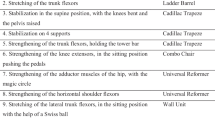Abstract
Introduction and hypothesis
Colpexin Sphere was effective for advanced pelvic organ prolapse. The aim of this study was to assess the effect of Colpexin Sphere in women with pelvic organ prolapse (POP) stage I or II on pelvic floor muscle strength, quality of life, and POP stage.
Methods
Women were randomly divided into Colpexin Sphere with pelvic floor muscle exercise group and exercise only group for a 16-week period. They had Colpexin pull test and digital test every 4 weeks. Quality of life and POP stage were re-evaluated at the end of treatment.
Results
Ninety-one women were recruited and 85 completed. Colpexin Sphere plus pelvic floor exercise improved pelvic floor muscle strength. There was no significant difference between both groups. Vaginal symptom score decreased in both groups while the stages of prolapse did not change.
Conclusions
Colpexin Sphere plus pelvic floor exercise and exercise alone improved pelvic floor muscle strength.

Similar content being viewed by others
References
Guerette N, Neimark M, Kopka SL, Jones JE, Davila GW (2004) Initial experience with a new method for the dynamic assessment of pelvic floor function in women; the Kolpexin Pull Test. Int Urogynecol J 15:39–43
Lukban JC, Aguirre OA, Davila GW, Sand PK (2006) Safety and effectiveness of Colpexin Sphere in the treatment of pelvic organ prolapse. Int Urogynecol J 17:449–454
Brakken IH, Majida M, Engh ME, Bo K (2010) Can pelvic floor muscle training reverse pelvic organ prolapse and reduce prolapse symptoms? An assessor-blinded, randomized, controlled trial. Am J Obstet Gynecol 203:170, e1-7
Bump RC, Mattiasson A, Bo K, Brubaker LP, DeLancey JO, Klarskov P et al (1996) The standardization of terminology of female pelvic organ prolapse and pelvic floor dysfunction. Am J Obstet Gynecol 175:10–17
Messelink B, Benson T, Berghmans B, Bo K, Corcos J, Fowler C et al (2005) Standardization of termination of pelvic floor muscle function and dysfunction: Report from the pelvic floor clinical assessment group of the International Continence Society. Neurourol Urodyn 24:374–380
Jean-Michel M, Biller DH, Bena JF, Davila W (2010) Measurement of pelvic floor muscular strength with the Colpexin pull test: A comparative study. Int Urogynecol J 21:1011–1017
Brink CA, Sampselle CM, Wells TJ, Diokno AC, Gillis GL (1989) A digital test for pelvic muscle strength in older women with urinary incontinence. Nurs Res 38:196–199
Harnsomboon T, Manonai J, Sarit-aprak S, Wattanayingcharoenchai R, Chittacharoen A, Suthutvoravut (2010) Effect of colpexin sphere on pelvic floor muscle strength in women with pelvic organ prolapse: A randomized controlled trial (a preliminary report). Arch Gynecol Obstet 283:575–579
Price N, Jackson SR, Avery K, Brookes ST, Abrams P (2006) Development and psychometric evaluation of the ICIQ Vaginal Symptoms Questionnaire: ICIQ-VS. BJOG 113:700–712
Chen L, Ashton-Miller JA, Hsu Y, DeLancey JO (2006) Interaction among apical support, levator ani impairment, and anterior vaginal wall prolapse. Obstet Gynecol 108:324–332
Hove MS, Pool-Goudzwaard A, Eijkemans M, Steegers-Theunissen R, Burger C, Vierhout M (2010) Pelvic floor muscle function in a general population of women with and without pelvic organ prolapse. Int Urogynecol J 21:311–319
Hagen S, Stark D, Maher C, Adams E (2006) Conservative management of pelvic organ prolapse in women. Cochrane Database Syst Rev 4:CD003882
Hagen S, Stark D, Glazener C, Sinclair L, Ramsay I (2009) A randomized controlled trial of pelvic floor muscle training for stage I and II pelvic organ prolapse. Int Urogyecol J Pelvic Floor Dysfunct 20:45–51
Braekken IH, Majida M, Engh ME, Bo K (2010) Morphological changes after pelvic floor muscle training measured by 3-dimensional ultrasonography: A randomized controlled trial. Obstet Gynecol 115:317–324
Samuelsson EC, Victor FT, Tibblin G, Svardsudd KF (1999) Signs of genital prolapse in a Swedish population of women 20–59 years of age and possible related factors. Am J Obstet Gynecol 180:299–305
Phillips CH, Anthony F, Benyon C, Monga AK (2006) Collagen metabolism in the uterosacral ligaments and vaginal skin of women with uterine prolapse. BJOG 113:39–46
Mouritsen L (2005) Classification and evaluation of prolapse. Best Pract Res Clin Obstet Gynaecol 19:895–911
Acknowledgments
This study was funded by Faculty of Medicine Ramathibodi Hospital, Mahidol University, Bangkok, Thailand.
Conflicts of interest
None.
Author information
Authors and Affiliations
Corresponding author
Rights and permissions
About this article
Cite this article
Manonai, J., Harnsomboon, T., Sarit-apirak, S. et al. Effect of Colpexin Sphere on pelvic floor muscle strength and quality of life in women with pelvic organ prolapse stage I/II: a randomized controlled trial. Int Urogynecol J 23, 307–312 (2012). https://doi.org/10.1007/s00192-011-1569-y
Received:
Accepted:
Published:
Issue Date:
DOI: https://doi.org/10.1007/s00192-011-1569-y




